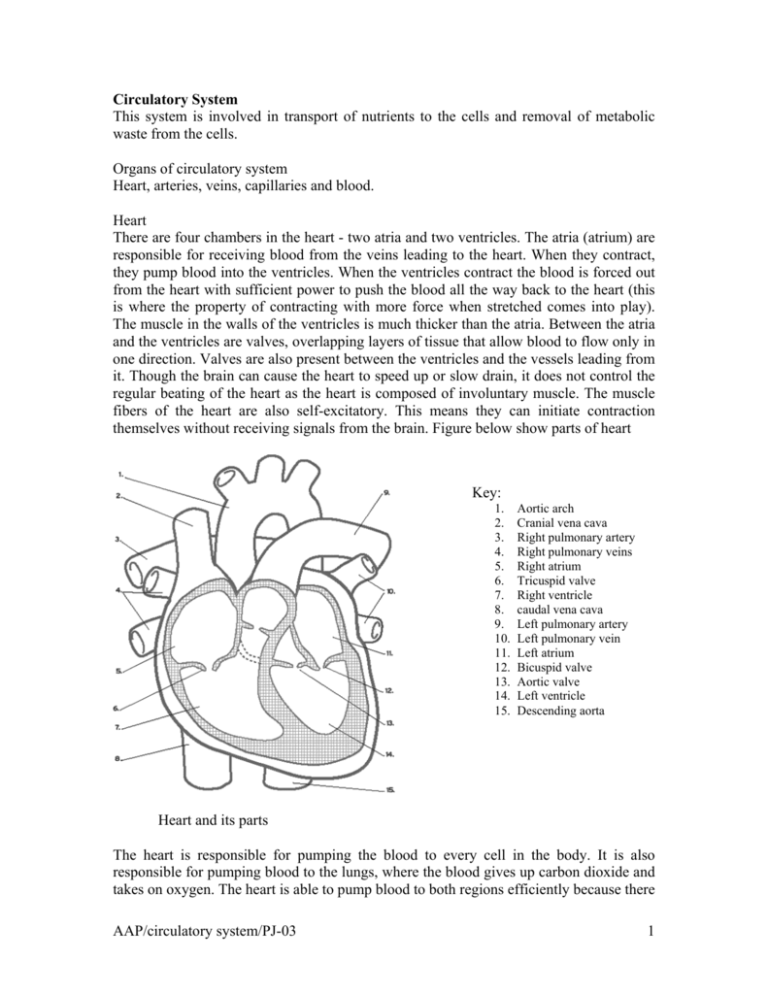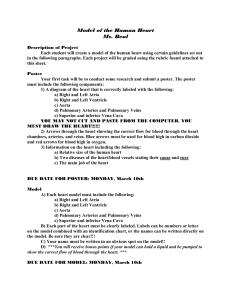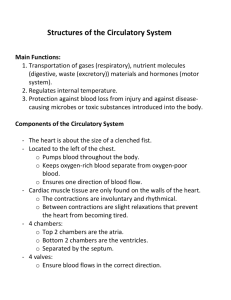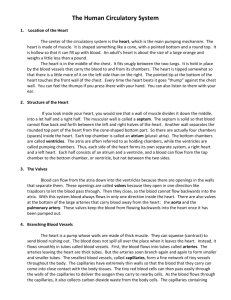circulatory system
advertisement

Circulatory System This system is involved in transport of nutrients to the cells and removal of metabolic waste from the cells. Organs of circulatory system Heart, arteries, veins, capillaries and blood. Heart There are four chambers in the heart - two atria and two ventricles. The atria (atrium) are responsible for receiving blood from the veins leading to the heart. When they contract, they pump blood into the ventricles. When the ventricles contract the blood is forced out from the heart with sufficient power to push the blood all the way back to the heart (this is where the property of contracting with more force when stretched comes into play). The muscle in the walls of the ventricles is much thicker than the atria. Between the atria and the ventricles are valves, overlapping layers of tissue that allow blood to flow only in one direction. Valves are also present between the ventricles and the vessels leading from it. Though the brain can cause the heart to speed up or slow drain, it does not control the regular beating of the heart as the heart is composed of involuntary muscle. The muscle fibers of the heart are also self-excitatory. This means they can initiate contraction themselves without receiving signals from the brain. Figure below show parts of heart Key: 1. 2. 3. 4. 5. 6. 7. 8. 9. 10. 11. 12. 13. 14. 15. Aortic arch Cranial vena cava Right pulmonary artery Right pulmonary veins Right atrium Tricuspid valve Right ventricle caudal vena cava Left pulmonary artery Left pulmonary vein Left atrium Bicuspid valve Aortic valve Left ventricle Descending aorta Heart and its parts The heart is responsible for pumping the blood to every cell in the body. It is also responsible for pumping blood to the lungs, where the blood gives up carbon dioxide and takes on oxygen. The heart is able to pump blood to both regions efficiently because there AAP/circulatory system/PJ-03 1 are really two separate circulatory circuits with the heart as the common link, right heart in the pulmonary circuit and left heart in the systemic circuit and third circuit supply blood to heart. Pulmonary circuit In the pulmonary circuit, blood leaves the heart through the pulmonary arteries, goes to the lungs, and returns to the heart through the pulmonary veins. Systemic circuit In the systemic circuit, blood leaves the heart through the aorta, goes to all the organs of the body through the systemic arteries, and then returns to the heart through the systemic veins. Coronary circuit The heart is supplied by its own set of blood vessels. These are the coronary arteries. There are two main ones with two major branches each. They arise from the aorta right after it leaves the heart. The coronary arteries eventually branch into capillary beds that course throughout the heart walls and supply the heart muscle with oxygenated blood. The coronary veins return blood from the heart muscle, but instead of emptying into another larger vein, they empty directly into the right atrium. Cranial vena cava Head Caudal vena cava Lungs GI tract Pulmonary artery Aorta Pulmonary vein Hindquarter Kidneys Liver Left atrium Valve Left ventricle Right ventricle Right atrium Circulation in animal body Blood vessels There are three types of vessels - arteries, veins and capillaries. Arteries, veins, and capillaries are not anatomically the same. They are not just tubes through which the blood flows. Both arteries and veins have layers of smooth muscle surrounding them. Arteries have a much thicker layer, and many more elastic fibers as well. Arteries have to expand to accept the blood being forced into them from the heart, and then squeeze this blood on to the veins when the heart relaxes. Arteries have the property of elasticity, meaning that they can expand to accept a volume of blood, then contract and squeeze back to their AAP/circulatory system/PJ-03 2 original size after the pressure is released. A good way to think of them is like a balloon. When you blow into the balloon, it inflates to hold the air. When you release the opening, the balloon squeezes the air back out. It is the elasticity of the arteries that maintains the pressure on the blood when the heart relaxes, and keeps it flowing forward. Artery (thick wall) Vein (Thin wall) Valve Capillary Figure showing blood vessel Capillaries are really more like a web than a branched tube. It is in the capillaries where the exchange between the blood and the cells of the body takes place. Here the blood gives up its carbon dioxide and takes on oxygen. In the special capillaries of the kidneys, the blood gives up many waste products in the formation of urine. Capillary beds are also the sites where white blood cells are able to leave the blood and defend the body against harmful invaders. As the capillaries begin to thicken and merge, they become venules. Venules eventually become veins and head back to the heart. Veins do not have as many elastic fibers as arteries. Veins do have valves, which keep the blood from pooling and flowing back to the legs under the influence of gravity. When these valves break down, as often happens in older or inactive people, the blood does flow back and pool in the legs. The result is varicose veins, which often appear as large purplish tubes in the lower legs. Arteries always carry blood away from the heart and veins always carry blood toward the heart. Most of the time, arteries carry oxygenated blood and veins carry deoxygenated blood. There are exceptions. The pulmonary arteries leaving the right ventricle for the lungs carry deoxygenated blood and the pulmonary veins carry oxygenated blood. If you are confused as to which way the blood flows through the heart, try this saying "When it leaves the right, it comes right back, but when it leaves the left, it's left." The blood does not have to travel as far when going from the heart to the lungs as it does from the heart to the toes. It makes sense that the heart would be larger on one side than on the other. When you look at a heart, you see that the right side of the heart is distinctly smaller than the left side, and the left ventricle is the largest of the four chambers. Blood Is the liquid form of tissue and it connects all parts of animal body during circulation. Functions of blood - carries oxygen and nutrients to body cells - carry carbon dioxide from cells to lungs for removal AAP/circulatory system/PJ-03 3 - carries secretions and metabolic wastes away from cells - contains phagocytic cells that fight infection - carry hormones from endocrine glands to target cells - maintain water balance - prevent excess loss of blood by clotting - contains chemicals that buffer internal pH - helps maintain normal body temperature. (birds and mammals; distributes metabolic heat within the body and helps rid body of excess heat) Blood constituents - Plasma (50% - 60% of total volume) composed mostly of water (92%), but also contains proteins, some of which function in clotting. Plasma also contains ions, glucose, lipids, amino acids, vitamins, globulins, albumin, hormones and dissolved gases. -Serum is the fluid part of blood from which fibrinogen is removed - Cells Red blood cells (RBCs; erythrocytes) In lower vertebrates and birds, the RBCs are nucleated. In mammals, the RBCs are anucleated. In either case, RBCs contain hemoglobin (an iron-containing protein) that binds with oxygen. RBCs form from stem cells in the bone marrow.) Red blood cells White blood cells (leukocytes) (nucleated, phagocytic cells that remove worn-out RBCs and unwanted cell debris from the bloodstream. Leukocytes are also formed from stem cells in the bone marrow. There are five types: Lymphocytes (B and T cells of immune system), monocytes (differentiate into macrophages), neutrophils (60% of WBCs), eosinophils, and basophils (allergic responses) monocyte Lymphocyte basophil eosinophil neutrophil Platelets anucleate fragments of megakayocytes (very large cells located in the bone marrow). Platelets function in blood clotting) AAP/circulatory system/PJ-03 4 Clinical importance 1. Anaemia: is a condition in which either there is less red blood cells (RBC) in circulation or haemoglobin content in RBC. Anaemia can occur when there is heavy parasite infestation (endoparasite or ectoparsite), haemorrhage (internal of external) can also result in anaemia. Protozoan infection like Babesiosis cause anaemia due heavy destruction of RBC. 2. Oedema: Is the accumulation of fluid in tissue. This mainly due to imbalance in osmotic pressure between blood and tissue. This is seen when there is heavy parasite like Liver fluke infestation causing decrease in blood protein level that reduces osmotic pressure in blood resulting in drainage of fluid from blood into tissue in dependent parts. More info http://members.aol.com/Bio50/LecNotes/lecnot16.html AAP/circulatory system/PJ-03 5







